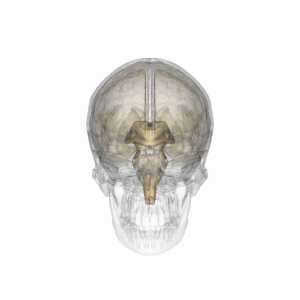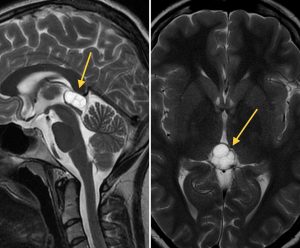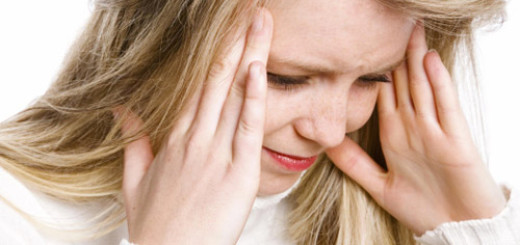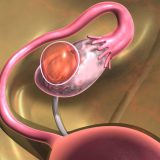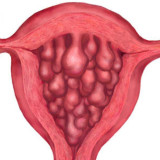The pineal gland is located in the back of the middle brain, located in the third chamber. The gland is connected with the brain part that is responsible for most of the mental and physical processes. The size of the pineal gland is only about 10 mm, but it has a huge impact on a human life. That is why pineal cyst is a terrible problem.
Pineal gland functions
Mood
Pineal gland cells – pinealocytes – produce serotonin. It is a hormone responsible for regulating the functions of the central nervous system and blood pressure. In other words – it is responsible for the overall mental state and mood, so it is usually called the “hormone of happiness”. When the hormone is in lack, the person becomes nervous, irritable and even aggressive. When serotonin level is very low depression occurs.
Sleep
Serotonin is produced during the day. At night serotonin is replaced with melatonin, the so-called “sleep hormone”. Melatonin synthesizing largely depends on the light intensity that enters the brain through nerve impulses. Little light is the signal for the pineal gland that night falls and it starts the produce melatonin. It is that hormone that makes a person sleepy.
The pineal gland also produces growth hormone and gonadotropins, which is especially important role in puberty. If this process occurs prematurely, it is a sign of excessive activity of the gland and may indicate the presence of a tumor.
DMT
But the properties of the pineal gland do not end there. It also produces DMT. DMT is classified as psychoactive substance, and its increased production leads to hallucinations and experiences similar to clinical death: a sense of going beyond the body, the indefinite presence of strange creatures, auditory hallucinations – the presence of unearthly sounds, reaching peace, harmony states etc. It is believed that this substance is responsible for pictures and experiences while sleeping.
Pineal cyst
Symptoms
When tumors or cysts appear in the pineal gland, it usually stops functioning properly – although not always.
The cyst symptoms may be different. The most common are dizziness, severe headaches and vomiting. Headache is quite a characteristic symptom, because the pain does not stop even after taking painkillers. The reason for this is the pressure on the adjacent structures of the brain made by the pineal cyst, which, for example, participate in the regulation of cerebrospinal fluid.
Other symptoms that indicate pineal cyst growth are insomnia, sleep disorders and wakefulness.
A brain tumor can press on the cerebellum and the brain stem, which leads to the eyelid retraction and vision loss. There may also be problems with eye mobility or nystagmus and strabismus.
Another symptom of the tumor is premature puberty. In case of boys, its signs are the appearance of hair on the face and underarms and voice changing before getting the age of nine years. In girls, it is characterized by acne and breast augmentation up to eight years.
The pineal cyst can be detected by MRI (magnetic resonance imaging).
How to prevent the appearance of pineal cyst
In the case of the pineal gland, unfortunately, we can’t talk about one hundred percent insurance of prevention cysts, but there are several ways to give the gland optimal working conditions. The main thing is not to wake up at night and sleep enough. This will maintain the circadian rhythm and adequate production of serotonin and melatonin.
It is also recommended to consume enough water and make sure that your daily diet contains enough magnesium, iodine, vitamins K and B.
Causes of pineal cysts
A pineal gland cyst is filled with a fluid containing the so-called inflammatory cells such as white blood cells, macrophages, or lymphocytes.
It is still unknown what is the direct cause of the pineal cysts formation. The development of pineal cysts is not affected by unhaealthy lifestyle or nutrition.
Statistics show that the pineal gland most often affects people of the young age. Scientists explain that at this stage the tissue, from which the pineal gland structure is built, undergoes numerous transformations. So teenage may get brain sand a or develop a cyst of the pineal gland.
Cysts treatment
The main role in the pineal gland cysts treatment performs surgery. However, they are carried out only when they are really necessary. That means when the patient has symptoms associated with the presence of pineal gland changes in size or when he has a malignant tumor.
Radiotherapy and chemotherapy are also used. The procedure used depends on the exact type of tumor of the pineal gland, which appeared in the patient.
However, in the case of small, asymptomatic lesions in the pineal gland, which are likely moderate, it is only possible to track changes in the size of the cyst. In this case, the cyst does not pose a threat to the life and the treatment is based on the elimination of symptoms. As the symptoms are most often associated with pressure on other brain organs, which causes pain, patients take painkillers. Such as ibuprofen, paracetamol or other, much stronger drugs like ketoprofen.
If the pineal gland cyst diagnosed, there is the need of periodic monitoring of the cyst development at least every three months. It is also important to inform your doctor about any symptoms and their changes regarding the pineal body, even those that seem trivial and insignificant, because they can be a signal of pineal cyst growth.
If the pineal cyst becomes too large, it brings very serious consequences for the life. Therefore, the doctor may decide to remove it surgically.
